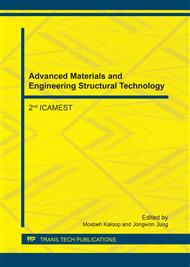[1]
G. Vitorasso, D. Pereira, Comparative analysis of the poultry environment with different packaging systems, Revista Brasileira de Engenharia Agrícola e Ambiental, 13(6) (2009) 788-794.
DOI: 10.1590/s1415-43662009000600018
Google Scholar
[2]
P. G. Abreu, V. N. M. Abreu, A. Coldebella, L. S. Lopes, V. Conceição, I. L. Tomazelli, Thermal analysis of the surface temperature of tiles, Revista Brasileira de Engenharia Agrícola e Ambiental, 15(11) (2011) 1193-1198.
DOI: 10.1590/s1415-43662011001100013
Google Scholar
[3]
H. M. Sacht, J. A. Rossignolo, W. N. Santos, Evaluation of the thermal conductivity of lightweight concrete with expanded clay, Matéria, 15(1) (2010) 31-39.
Google Scholar
[4]
J. Padilha, R. D. Toledo Filho, P. R. L. Lima, K. Joseph, A. Leal, Lightweight reinforced mortar with sisal pulp: Low thermal conductivity composite for use in rural buildings, Engenharia Agrícola, 21(1) (2001) 1-11.
Google Scholar
[5]
M. N. Conceição, S. P. Alves, A. Telatin Júnior, I. J. O. Silva, S. M. S. Piedade, H. Savastano Júnior, G. Tonoli, Performance of tiles with blast furnace slag and vegetable fibers for shed prototypes, Revista Brasileira de Engenharia Agrícola e Ambiental, 12(5) (2008).
DOI: 10.1590/s1415-43662008000500015
Google Scholar
[6]
L. A. Rossi, P. E. R. Cardoso, A. L. Beraldo, Thermal evaluation of cement mortar plates with rice husks heated by electric resistance, Engenharia Agrícola, 25(1) (2005) 37-45.
Google Scholar
[7]
M. P. Cruz, R. J. P. Ferreira, G. S. Marinho, Application of industrial waste for thermal insulation of environments. In. XXIX Encontro Nacional de Engenharia de Produção, Salvador. Anais.., Salvador: (2009) 1-8.
Google Scholar
[8]
P. R. L. Lima, M. B. Leite, E. Q. R. Santiago, Recycled lightweight concrete made from footwear industry waste and CDW, Waste Manag. 30(6) (2010) 1107-1113.
DOI: 10.1016/j.wasman.2010.02.007
Google Scholar
[9]
E. Q. R. Santiago, P. R. L. Lima, M. B. Leite, R. D. Toledo Filho, Mechanical behavior of recycled lightweight concrete using EVA waste and CDW under moderate temperature, Revista IBRACON de Estruturas e Materiais, 2(3) (2009) 211-221.
DOI: 10.1590/s1983-41952009000300001
Google Scholar
[10]
M. P. Oliveira, N. P. Barbosa, S. M. Torres, A. F. Leal, C. G. Silva, Gypsum based composites with residues of EVA and vermiculite, Revista Brasileira de Engenharia Agrícola e Ambiental, 16(6) (2012) 684-689.
DOI: 10.1590/s1415-43662012000600014
Google Scholar
[11]
F. M. D. Rocha, A. B. Melo, E. P. Silva, S. M. Torres, Precast block (EVAi block) for interlocking masonry: design, production, performance and simulation of use in social housing, Ambiente Construído, 13(2) (2013) 47-60.
Google Scholar
[12]
N. T. Arruda Filho, C. P. Dantas, A. F. Leal, N. P. Barbosa, C. G. Silva, M. V. Alexandre, Mechanical strength of lightweight cement based composites using industrial waste and sisal fibers, Revista Brasileira de Engenharia Agrícola e Ambiental, 16(8) (2012).
DOI: 10.1590/s1415-43662012000800012
Google Scholar
[13]
J. R. M. D´Almeida, R. C. M. P. Aquino, S. N. Monteiro, Tensile mechanical properties, morphological aspects and chemical characterization of piassava (Attalea funifera) fibers, Composites: Part A, 37(9) (2006) 1473-1479.
DOI: 10.1016/j.compositesa.2005.03.035
Google Scholar
[14]
P. R. L. Lima, R. D. Toledo Filho, Use of metakaolin to increase the durability of cement-based composites reinforced with sisal fibers, Ambiente Construído, 8(4) (2008) 7-19.
Google Scholar
[15]
R. Siddique, J. Khatib, I. Kaur, Use of recycled plastic in concrete: A review, Waste Manag. 28(10) (2008) 1835-1852.
DOI: 10.1016/j.wasman.2007.09.011
Google Scholar
[16]
Z. Z. Ismail, E. A. AL-Hashmi, Use of waste plastic in concrete mixture as aggregate replacement, Waste Manag. 28(11) (2008) 2041-(2047).
DOI: 10.1016/j.wasman.2007.08.023
Google Scholar
[17]
P. R. L. Lima, R. D. Toledo Filho, J. Melo Filho, Compressive stress-strain behaviour of cement mortar-composites reinforced with short sisal fibre, Mater. Res. 17(1) (2014) 38-46.
DOI: 10.1590/s1516-14392013005000181
Google Scholar
[18]
P. R. L. Lima, R. D. Toledo Filho, J. M. Lima, Cracking mechanism under direct traction of short sisal fiber reinforced cement based composites, Engevista, 15 (2013) 95-103.
Google Scholar
[19]
S. R. Ferreira, P. R. L. Lima, F. A. Silva, R. D. Toledo Filho, Effect of sisal fiber hornification on the fiber-matrix bonding characteristics and bending behavior of cement based composites, Key Eng. Mater. 600 (2014) 421-432.
DOI: 10.4028/www.scientific.net/kem.600.421
Google Scholar


